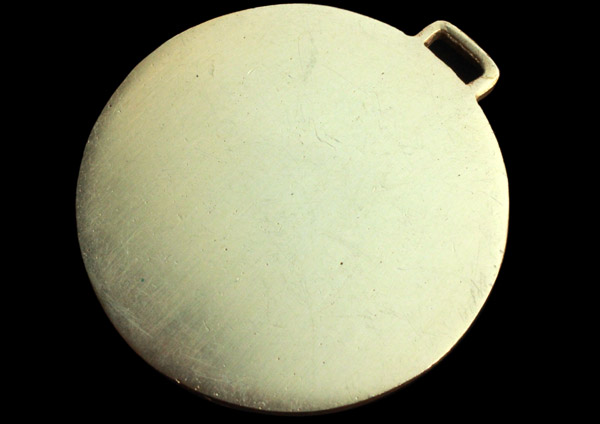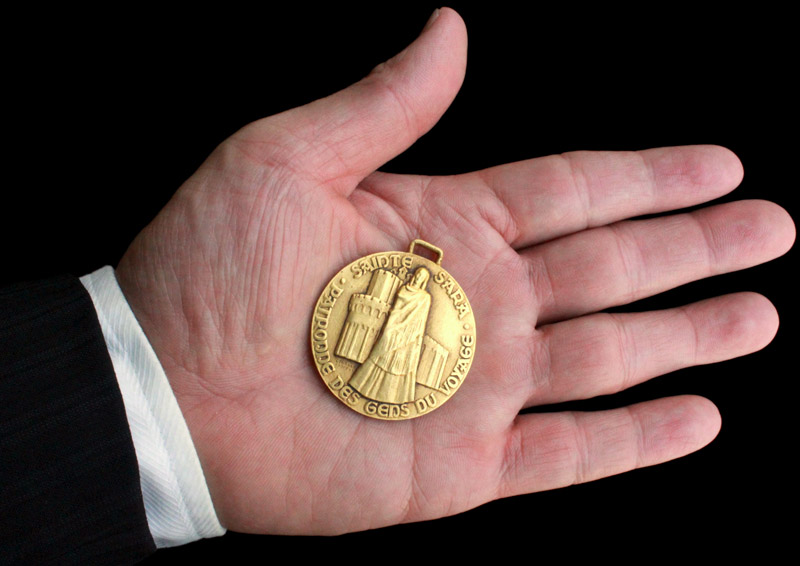


rare gold plated bronze medal by Léopold George Crouzat
Saint Sara, the patron saint of Gypsies, standing before the Basilica of Saintes Maries de la Mer, the Camargue, France
diameter: 41.6 mm (1.63 inches) without the bail
France, mid 20th century
This is a very rare medal of Saint Sara, the Egyptian girl who accompanied "the three Maries" from Palestine to the Camargue, France. This large medal, of which the diameter is over 1.6 inches, is an artwork by Léopold Georges Crouzat (1904 - 1977), a very versatile French artist.

On this medal Saint Sara, clad in Near-Eastern costume, stands before
the Basilique des Saintes Maries de la Mer. A French insciption surrounds her that says "Saint Sara, patron
saint of the people of journey" (French: "Sainte Sara, patronne
des gens du voyage.") The phrase "the people of journey"
means Gypsies.
According to an old tradition from the 9th century, which is also found
in the Golden Legend ("Legenda Aurea" XCVI, circa 1260), three saintly women, Mary Magdalene, Mary Salome and Mary Jacobe, fled persecution in Palestine and migrated
to France in a small boat that had neither sail nor rudder. They arrived
by God's providence in the Camargue in the Southern France. Of the three
Maries, Mary Magdalene, after spreading the Gospel in Marseille, moved
to the Sainte Baume mountains to live in her hermitage in a cave, which
is now called "la Sainte Baume"(the holy cave). Mary Salome and
Mary Jacobe, together with their servant Sara, remained in the Camargue
to spread the Gospel. The three women lead saintly lives, were respected
by the indigenous people, died and were buried there.
Sara, sometimes called "Sara Kali", which means "Sara of
dark skin" or "Sara the Gypsy", is the patron saint of Gypsies.
Saintes-Maries-de-la-Mer, as the sanctuary of Sara Kali, has attracted
Gypsy pilgrims from all around Europe since mid 19th century. Thousands
of Gypsies from different European countries gather at the basilica there
on the fourth weekend every May. During the Saturday mass, while the pilgrims
sing hymns to Sara Kali, the reliquary is lowered down slowly from the
ceiling of the church. When the statue of Sara Kali is brought up from
the underground chapel, the pilgrims make a procession to the seashore,
walking on a path strewn with rose petals. At the end of the feast the
pilgrims offer a prayer that says:
"Saint Sara, show us the right way. Give us good faith and good health.
Change the mind of those who dislike us, and make them kind to us."

This medal was made by Léopold Georges Crouzat (1904 - 1977), a French
painter and sculptor. Crouzat studied under Paul Maximilien Landowski (1875
– 1961) at the École nationale supérieure des Beaux-Arts de Paris, ENSBA.
He got a "mention honorable" in 1928, and a silver medal in 1938,
both at the Salon des artistes français. He was also accorded a silver
medal at the Paris Expo in 1937.
Paul Maximilien Landowski, the teacher of Crouzat, is a sculptor of Polish
origin. The huge statue of Jesus Christ in Rio de Janeiro is a work by
him.
JPN 7,800 + tax SOLD
Don't hesitate to contact us at procyon_cum_felibus@yahoo.co.jp
to the index of the medals of the Saintes Maries de la Mer
to the gallery index of the medals of angels and saints
to the index of the medals of angels and saints
to the index of religious medals
to the index of religious items
to the top page of the website of Antiques Anastasia
Ἀναστασία ἡ Οὐτοπία τῶν αἰλούρων ANASTASIA KOBENSIS, ANTIQUARUM RERUM LOCUS NON INVENIENDUS